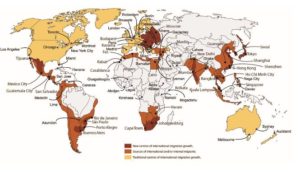How migration is changing the world’s cities
 Soaring global migration is fundamentally changing how and where most people live, a new report shows.
Soaring global migration is fundamentally changing how and where most people live, a new report shows.
Focusing on settlement in cities, the report by the World Economic Forum, identified housing, healthcare, education and employment as the critical areas for successful settlement and integration.
It said that in 2015 more than a billion became migrants with 244 million traveling abroad and 763 million moving within their own countries.
Some travelled by plane with passports, visas and jobs to go to while others risked their lives in crowded boats, fleeing war or famine.
Yet others left the countryside in search of jobs and a better quality of life.
The overwhelming majority of these people moved to cities.
The report, released this month, looks at these patterns of migration and how they affect the world’s cities.
Overall, numbers of migrants are soaring. Between 2000 and 2015 annual migration has grown was 2.4 per cent or double the world’s annual population growth.
Almost twenty per cent of the world’s total went to live in the United States while Germany and Russia together took in almost 10 per cent.
However, when you look at the number of migrants as a proportion of the total population, migrants to Middle Eastern countries far outstrip any other. More than 80 per cent of the population in the United Arab Emirates is foreign-born, the report says.
It says migrants tend to head to global cities with Dubai and Brussels having the highest number of foreign-born population at 83 per cent and 62 per cent respectively.
Of the nearly seven million foreign-born people living in Canada, almost half (46%) live in Toronto.
Over one-third (36%) of Americans live in just 20 US cities. Those same cities are also home to two-thirds (65%) of the country’s authorised immigrants.
In Australia, 6.6 million people – or about a quarter of the population – were born overseas. Of those, 1.4 million live in Sydney and 1.2 million live in Melbourne.
The report analyses some of the routes migrants take and it shows how people from East African countries cross the Mediterranean and hit the shores of Italy and Greece. Others take route via the Indian Ocean from south-west Asia into Malaysia.
It also shows how patterns of migration are changing. Some areas have seen increased migration in recent years. Sao Paulo in Brazil, Moscow in Russia and Cape Town in South Africa are all cited as cities with a growing international population.
Other areas have become both an origin, as well as a destination for migration, the report says.
While Nigerians head into China, many Chinese are heading to the Middle East and Africa.
Some cities, such as those in China, have seen rapid expansion in recent years, in part because of a huge increase in migration.
“Migration can have a positive effect on a country’s economy. But cities need to be prepared for the new arrivals if they are to harness the benefits,” the report said.
It looks at how 22 of the most affected cities around the world are coping with an influx of migrants.
The four main challenges facing city chiefs identified in the report are: housing, health, education and employment.
“Almost all the cities reported a need for more affordable and social housing. This wasn’t only for migrants, but for the existing population too,” the report said.
Migrants also need to be able to access healthcare that addresses their particular needs, the report said.
Sixteen cities recognised that their healthcare services needed to be improved.
“Education and employment are basic needs, but migrants often struggle to access both,” the report said.
“Fifteen cities said that giving young migrants a primary and secondary education was a significant challenge,” it said.
“Eight of the 15 said that one of the biggest issues was migrants not speaking the language of their new city, and the challenge this posed to their successful integration.
While access to employment and the labour market is a challenge in all cities, 11 of them cited employment-related issues that must be addressed.
Six cities – Berlin, Rotterdam, Amman, Ramallah, Davao City and Cape Town – saw their growing rate of unemployment as a challenge. Amman and Cape Town were among the cities studied in the report with the highest unemployment rates.
The report said that fostering migrant entrepreneurship can help the local economy, and cities should provide training and mentoring support.
It also outlined the economic benefits of migration citing that in 2015 migrants contributed over $US6.4 trillion, or 9.4 per cent, to global GDP.
The UN’s Sustainable Development Goals recognise that well-managed migration will play an integral role in achieving sustainable development for cities, the report said.
It said that cities can learn from each other’s initiatives, and work even more closely together in the future.
See the full report here: https://www.weforum.org/agenda/2017/10/how-migration-is-changing-world-cities-charts/
Laurie Nowell
AMES Australia Senior Journalist












